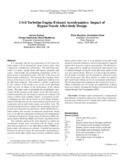JavaScript is disabled for your browser. Some features of this site may not work without it.
| dc.contributor.author | Goulos, Ioannis | |
| dc.contributor.author | Stankowski, Tomasz | |
| dc.contributor.author | MacManus, David G. | |
| dc.contributor.author | Woodrow, Philip | |
| dc.contributor.author | Sheaf, Christopher T. | |
| dc.date.accessioned | 2017-09-13T09:14:38Z | |
| dc.date.available | 2017-09-13T09:14:38Z | |
| dc.date.issued | 2017-09-11 | |
| dc.identifier.citation | Ioannis Goulos, Tomasz Stankowski, David MacManus, Philip Woodrow, Christopher Sheaf, Civil turbofan engine exhaust aerodynamics: Impact of bypass nozzle after-body design, Aerospace Science and Technology, Volume 73, February 2018, Pages 85-95 | en_UK |
| dc.identifier.issn | 1270-9638 | |
| dc.identifier.uri | http://dx.doi.org/10.1016/j.ast.2017.09.002 | |
| dc.identifier.uri | https://dspace.lib.cranfield.ac.uk/handle/1826/12476 | |
| dc.description.abstract | It is envisaged that the next generation of civil large turbofan engines will be designed for greater bypass ratios when compared to contemporary architectures. The underlying motivation is to reduce specific thrust and improve propulsive efficiency. Concurrently, the aerodynamic performance of the exhaust system is anticipated to play a key role in the success of future engine architectures. The transonic flow topology downstream of the bypass nozzle can be significantly influenced by the after-body geometry. This behavior is further complicated by the existence of the air-flow vent on the nozzle after-body which can have an impact on the performance of the exhaust system. This paper aims to investigate the aerodynamics associated with the geometry of the bypass nozzle after-body and to establish guidelines for the design of separate-jet exhausts with respect to future large turbofan engines. A parametric geometry definition has been derived based on Class-Shape Transformation (CST) functions for the representation of post-nozzle-exit components such as after-bodies, plugs, and air-flow vents. The developed method has been coupled with an automatic mesh generation and a Reynolds Averaged Navier–Stokes (RANS) flow solution method, thus devising an integrated aerodynamic design tool. A cost-effective optimization strategy has been implemented consisting of methods for Design Space Exploration (DSE), Response Surface Modeling (RSM), and Genetic Algorithms (GAs). The combined approach has been deployed to explore the aerodynamic design space associated with the bypass nozzle after-body geometry for a Very High Bypass Ratio (VHBR) turbofan engine with separate-jet exhausts. A detailed investigation has been carried out to expose the transonic flow mechanisms associated with the effect of after-body curvature combined with the impact of the air-flow vent. A set of optimum curved after-body geometries has been obtained, with each subsequently compared against their respective conical representation. The obtained results suggest that no significant performance improvements can be obtained through curving the nozzle after-body relative to the case of a conical design. However, it is shown that the application of surface curvature has the potential to unlock new parts in the design space that allow analysts to reduce the required after-body length without any loss in aerodynamic performance. The developed approach complements the existing tool-set of enabling technologies for the design and optimization of future large aero-engines, consequently leading to increased thrust and reduced Specific Fuel Consumption (SFC). | en_UK |
| dc.language.iso | en | en_UK |
| dc.publisher | Elsevier | en_UK |
| dc.rights | Attribution-NonCommercial-NoDerivatives 4.0 International | |
| dc.rights.uri | http://creativecommons.org/licenses/by-nc-nd/4.0/ | |
| dc.subject | Turbofan engine aerodynamics | en_UK |
| dc.subject | Computational fluid dynamics | en_UK |
| dc.subject | Propulsion integration | en_UK |
| dc.subject | Class-shape transformation functions | en_UK |
| dc.subject | Exhaust nozzles | en_UK |
| dc.subject | Annular after-bodies | en_UK |
| dc.subject | Design optimization | en_UK |
| dc.subject | Transonic flow aerodynamics | en_UK |
| dc.title | Civil turbofan engine exhaust aerodynamics: impact of bypass nozzle after-body design | en_UK |
| dc.type | Article | en_UK |
Files in this item
This item appears in the following Collection(s)
-
Staff publications (SATM) [4472]

